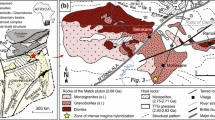Abstract
A post-tectonic unzoned granite intrusion in the Meatiq Dome, a Late Proterozoic metamorphic complex in the Central Eastern Desert of Egypt, shows significant chemical and mineralogic heterogeneity on the scale of sampling (∼5 kg). Whole rock analyses of 21 samples indicate small variations in SiO2, Al2O3, Na2O and K2O, and larger systematic variations in the less abundant major elements such as FeO, TiO2, CaO, MnO and MgO, and trace elements such as Sc, Cr, Co, Rb, Sr, Zr, La, Ce, Nd, Sm, Tb, Yb, Lu, Ta, Th and U. These variations cannot be accounted for by processes such as marginal accretion, assimilation, alteration by late stage fluids, or multiple intrusion. Instead, we proposed a model involving 35 percent solidification of the granite magma followed by partial solid-liquid segregation during emplacement, resulting in rocks containing 7–71 volume percent early-formed solids. Such randomly distributed local segregation could have been caused by filter pressing, flow differentiation, and possibly gravity segregation, either singly or in combination. Thus, each sample is interpreted as a mixture of two end-members with nearly constant compositions: an early-formed solid assemblage of crystals and a complementary residual liquid. Early formed solids are enriched in TiO2, FeO, CaO, P2O5, Sc, Co, Cr, Sr, La, Ce and depleted in SiO2, Rb, Yb, Lu, Ta, Th, and U, while the residual liquid has complementary enrichments and depletions. This simple mixing model is consistent with field and petrographic observations, experimental studies pertaining to the crystallization sequence in the system Ab-Or-Qtz-H2O at 1 Kb, and physical properties of silicic magmas. Furthermore, it is quantitatively supported by trace-element data for minerals, computed endmember compositions at 35% crystallization using mineral analyses and reasonable Kd values, and internal consistency in the percent solid for each sample computed from each of 17 elements in the inferred end-members. We suggest that this model might also apply to other small epizonal granite intrusions that show small-scale chemical heterogeneities.
Similar content being viewed by others
References
Albee AL, Ray L (1970) Correction factors for electron probe microanalysis of silicates, oxides, carbonates, phosphates, and sulfates. Analytical Chemistry 42:1408–1414
Bence AE, Albee AL (1968) Empirical correction factors for the electron microanalysis of silicates and oxides. J Geol 76:382–403
Bryan WB, Finger LW, Chayes F (1969) Estimating proportions in petrographic mixing equations by least-square approximation. Science 103:926–927
Fridrich CJ, Mahood GA (1984) Reverse zoning in the resurgent intrusions of the Grizzly Peak Cauldron, Sawatch Range, Colorado. Geol Soc Amer Bull 95:779–787
Gromet LP, Dymek RF, Haskin LA, Korotev RL (1984) The “North American shale composite”: its compilation, major and trace element characteristics. Geoch Cosmoch Acta 48:2469–2482
Gromet LP, Silver LT (1983) Rare earth element distributions among minerals in a granodiorite and their petrogenetic implications. Geoch Cosmoch Acta 47:925–939
Haskin LA (1984) Petrogenetic modelling — use of rare earth elements. In Henderson P (ed) Rare earth element geochemistry. Developments in geochemistry, vol 2. Elsevier, Amsterdam Oxford New York, pp 115–152
Haskin LA, Haskin MA, Frey FA, Wildeman TR (1968) Relative and absolute terrestrial abundances of the rare earths. In Ahrens LH (ed) Origin and distribution of the elements. Pergamon Press, New York, pp 889–912
Hildreth W (1977) The magma chamber of the Bishop Tuff: Gradients in temperature, pressure, and composition. PhD thesis Berkeley University of California
Jacobs JW, Korotev RL, Blanchard DP, Haskin LA (1977) A well-tested procedure for instrumental neutron activation analysis of silicate rocks and minerals. Journ. Radioanal Chem 40:93–114
Lindstrom MM, Haskin LA (1981) Compositional inhomogeneities in a single Icelandic tholeiitic flow. Geochim Cosmochim Acta 45:15–31
Lindstrom DJ, Korotev RL (1982) TEABAGS: Computer programs for instrumental neutron activation analysis. J Radioanal Chem 70:439–458
Long PE (1978) Experimental determination of partition coefficients for Rb, Sr and Ba between alkali feldspar and silicate liquid. Geochim Cosmochim Acta 42:833–846
Mahood GA (1981) A summary of the geology and petrology of the Sierra La Primavera, Jalisco, Mexico. J Geophys Res 86:10137–10152
Mahood G, Hildreth W (1983) Large partition coefficients for trace elements in high-silica rhyolites. Geochim Cosmochim Acta 47:11–30
McCarthy TS, Hasty RA (1976) Trace element distribution patterns and their relationship to the crystallization of granitic melts. Geochim Cosmochim Acta 40:1351–1358
McCarthy TS, Robb LJ (1978) On the relationship between cumulus mineralogy and trace and alkali element chemistry in an Archean granite from the Barberton region, South Africa. Geochim Cosmochim Acta 42:21–26
Miller CF, Mittlefehldt DW (1982) Depletion of light rare-earth elements in felsic magmas. Geology 10:129–133
Nagasawa H (1970) Rare earth concentrations in zircons and apatites and their host dacites and granites. Earth Planet Sci Lett 9:359–364
Norrish K, Hutton JT (1969) An accurate X-ray spectrographic method for the analysis of a wide range of geological samples. Geochim et Cosmochim Acta 33:431–454
Pierozynski WJ (1977) The effects of varying bulk composition on the partitioning of Sr, Ba, Rb between alkali feldspar and coexisting silicate liquid. In papers presented to the International Conference on experimental trace element geochemistry, pp 98–99
Shaw HR (1965) Comments on viscosity, crystal settling, and convection in granitic magmas. Am J Sci 263:120–152
Sturchio NC, Muehlenbachs K (1985) Origin of low-18O metamorphic rocks from a Late Proterozoic shear zone in the Eastern Desert of Egypt. Contrib Mineral Petrol 91:188–195
Sturchio NC, Sultan M, Batiza R (1983) Geology and origin of the Meatiq Dome, Egypt: A Precambrian metamorphic core complex? Geology 11:72–76
Tuttle OF, Bowen NL (1958) Origin of granite in the light of experimental studies in the system NaAlSi3O8-KAlSi3O8-SiO2-H2O. Geol Soc Amer Mem 74:153 p
Van Der Plas L, Tobi AC (1965) A chart for judging the reliability of point counting results. Am J Sci 263:87–90
Author information
Authors and Affiliations
Rights and permissions
About this article
Cite this article
Sultan, M., Batiza, R. & Sturchio, N.C. The origin of small-scale geochemical and mineralogic variations in a granite intrusion. Contr. Mineral. and Petrol. 93, 513–523 (1986). https://doi.org/10.1007/BF00371721
Received:
Accepted:
Issue Date:
DOI: https://doi.org/10.1007/BF00371721




